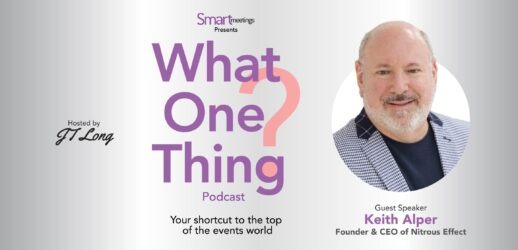How to creatively overcome post-pandemic staffing and supply shortages at medical meetings
Good news: corporate travel and events are back!
Bad news: the supply chain isn’t. And neither is the supply of talented staff.
 In the hospitality/events industry, a weak supply chain means limited product quantities unless you order significantly in advance (and who can predict volume right now?), or options don’t exist—those linens or new conference tables may just not be available. Period.
In the hospitality/events industry, a weak supply chain means limited product quantities unless you order significantly in advance (and who can predict volume right now?), or options don’t exist—those linens or new conference tables may just not be available. Period.
Add to that staffing shortages, leading to fewer employees wearing multiple hats, taking on tasks they normally wouldn’t, or weren’t trained for. With inflation also at play, room rates and F&B pricing are higher. Hotels are now less likely to negotiate rental fees and other typically negotiable line items.
Now let’s look at a major client for the hospitality industry: healthcare, from biotechnology, pharmaceuticals and medical technology (just to name a few) are all impacted. Pre-pandemic, the hospitality industry could create annual calendars for pharmaceutical clients, with predictable repeat business. Now, business units have a much harder time looking ahead, because some are growing like wildfire while others are being cut.
Pair this with a short turnaround time for healthcare meetings (back to the lack of predictability), plus the surge in live meetings put on pause from 2020 and 2021. The result is a massive wave of events cascading down on the events industry.
Read More: Smart Tech: The Great Resignation
As an event planner with healthcare clients, how can you change those challenges from barriers to benefits?
Top Tips for Navigating the Healthcare Meeting Landscape
1. Plan (Much Farther!) Ahead. Venues are booking up quickly and the preferred options are likely not going to be available—or what’s left will cost a premium. Post-pandemic, many people are ready to travel again, not only for work, but for leisure too.
Hotels are presented with high volume of transient/leisure travel requests that demand a high room rate (compared to group rates associated with meetings, especially with pharma sleeping room rate caps). Hotels are not as flexible as in the past and can truly demand a higher spend for better space/rooms offerings.
2. Collaborate to Consolidate. If you can combine different groups of people or different business units within an organization and make a consolidated booking, that’s a great opportunity to work with a national account manager for better pricing or general advantages with one brand. This is also a good approach for advisory board meetings with smaller budgets that have multiple meetings a year.
3. Multiple Choice Wins. Given the rate of change (for the industry and for staff), it’s wise to have options. Depending on timing or scope, your preferred partners may not be able to meet your needs. Having a second or third choice in every vendor category covers all contingencies.
Another reason to have a list: each vendor will have a “sweet spot” or particular skill set. By taking some time to map out vendor portfolio strengths, your event will be that much better with partners doing what they do best.
4. Share to Solve. Vendors work hard to be the best partner. The more information shared across all players, the better each team can meet your needs. Talk through your hurdles—tight budgets, changing timelines, improbable production requests like turning a live meeting into a hybrid meeting overnight, or constantly shifting meeting dates or venue preferences with short sourcing turnaround time—so your vendor partners can be part of the solution. (Plus, they’re going to see the issue or opportunity from a different perspective, adding new ideas to the mix.)
Transparency goes both ways. Meeting planners should ask vendor partners what they are up against, too. Working through potential obstacles together—and early—saves stress and adds creativity.
5. Plan & Partner On-Site. Just like your vendor portfolio, have a back-up plan for on-site staffing. We all know the staffing challenges in hospitality. Expect the unexpected!
On top of not having enough people to do the work, many experienced professionals left the industry during the pandemic. That adds up to fewer people and less experience. With this key group of talent, transparency is also top priority. Let them know your plans and invite them to be part of making the event a success. The more you can partner with on-site staff, the more they’ll feel like a partner instead of hired help.
6. Realism Releases Creativity. Post pandemic, meeting planners have to give venues more flexibility for deliverables. Not all the items on a banquet event order (BEO) might be ready, and at times the hotel will have to be creative with what did arrive. Attendees won’t know the difference if flowers were swapped for an ice sculpture, or the mixed berry tart is replaced with a banana cream pie because there were no fresh berries delivered to the island resort all week. The attendees will still enjoy a dessert.
Read More:
As a meeting planner, you excel at detailed instructions, but this is the time to let some things go. Especially with short-term bookings, be creative with what’s already on order or being served by another group. And ask the hotel what they’ve seen at their recent events. Trusting the venues and their real-time experience is more relevant right now than pre-pandemic experience.
“Transparency goes both ways. Meeting planners should ask vendor partners what they are up against, too. Working through potential obstacles together—and early—saves stress and adds creativity.”
All this might sound like more work. But these post-pandemic times add up to opportunity. As event planners, we’re creative problem-solvers. Right now, for healthcare industry events and beyond, we have plenty of space to shine.
Cathy Mariano, CMP, HMCC, Bishop-McCann Head, Pharmaceutical & Medical Client Group, brings more than 17 years of industry experience to her role. She’s known for building positive, long-lasting relationships and for creating memorable experiences in a collaborative, meaningful way.
This article appears in the August 2022 issue. You can subscribe to the magazine here.




